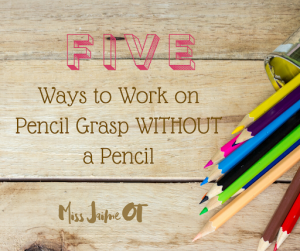
For an OT in the school system, pencil grasp can be a big focus for our students. Knowing how to encourage proper pencil grasp is helpful for all of our young students.
A tripod grasp is functional and it helps with a reduction of pain and hand fatigue.
Many teachers and therapists believe that the dynamic tripod is the only grasp that’s functional. However, there are other functional grasps that are just as sufficient as the tripod grasp. A tripod grasp does help with more things than just writing, like utilizing math manipulatives and engaging in kinesthetic learning with wiki sticks, Play-Doh, and clay.
It’s important to encourage good pencil grasp early on. After 2nd grade, a grasp becomes “locked-in” and is difficult to change.
Here are the 5 ways I use to work on pencil grasp with my students.
Use a Stylus
A stylus is convenient to utilize whenever my students want to engage in an activity on the IPad. I am truly passionate about the fact that the students I see have learned to use their index fingers so heavily. With technology at an all-time high, the use of a pencil has become very difficult to learn. Anytime your student is using an iPad, incorporate a stylus. I particularly like the crayon-shaped styluses for the younger ones (they are fun and relatable to them).
Use Skinny Dry Erase Markers
- Dry erase markers and chalk are always fun and engaging for the students
- Write on a dry erase board/table or utilize sidewalk chalk
- Use chalkboard paint to turn any wall or table into a fun writing surface
- Break the chalk into a shorter piece will aid in enforcing the proper grasp
Magna Doodle & Aqua Doodle
Magna Doodle and Aqua Doodle are awesome tools that make our students feel as if writing and drawing are play and not work (our specialty). Most children haven’t ever seen them.
- Introduce this tool to draw pre-writing shapes or scribble. They normally come with a short writing utensil (always a plus) and only require minimal storage space.
A Peg and Clay
- Use a short stick (it can be a spare peg, craft stick, etc) to draw in clay, Play-Doh, or shaving cream.
- You can make this into a creative game with your students.
- Have them draw a smiley face or a house. Practice shapes and lines.
This works on developing pencil grasp as well as pre-writing skills and visual-motor skills.
Use Fine Motor Toys
There are so many fun fine motor toys to help the development of our students’ pencil grasps.
- threading beads
- pegboard activities
- peeling stickers
- utilizing tongs
- stacking blocks
Want more ideas? Get a free printable handout!
About the Author:
 Brittany Turner is a COTA/L (Certified Occupational Therapy Assistant) and a new member of the Miss Jaime, O.T. team. She has been in the OT field since 2014. She currently works full-time in the public school system in Henry County, Virginia with students ranging from 2 years of age to 5th grade. She is also working PRN in a skilled nursing facility and inpatient rehabilitation. She’s busy in the OT field, but she loves seeing the variety of patients and learning new things constantly.
Brittany Turner is a COTA/L (Certified Occupational Therapy Assistant) and a new member of the Miss Jaime, O.T. team. She has been in the OT field since 2014. She currently works full-time in the public school system in Henry County, Virginia with students ranging from 2 years of age to 5th grade. She is also working PRN in a skilled nursing facility and inpatient rehabilitation. She’s busy in the OT field, but she loves seeing the variety of patients and learning new things constantly.
Brittany graduated with a Bachelor’s degree in Rehabilitation Studies from Winston Salem State University. She enjoys exercising, spending time with her family, and being involved in church activities.

Great ideas. Thank you very much.
This blog is nice to read and it sounds amazing! I love to do this types of skill improvement activities with my kids.